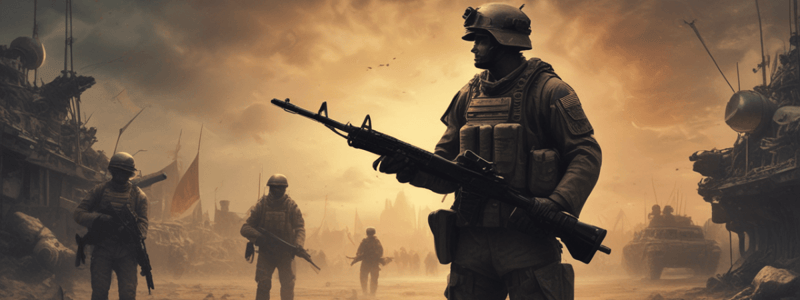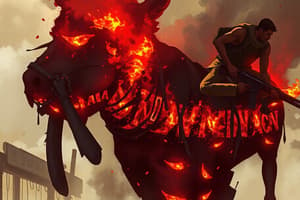Podcast
Questions and Answers
What is the primary goal of strategic envelopment?
What is the primary goal of strategic envelopment?
- To seal off the zone of operations from the enemy (correct)
- To conduct a fighting retirement
- To retreat without losing control
- To force an immediate surrender of enemy forces
What distinguishes a withdrawal from other maneuvers?
What distinguishes a withdrawal from other maneuvers?
- It aims to force the enemy into surrender
- It is a reaction to being under pressure
- It involves a loss of control over forces
- It is a voluntary effort to break contact with the enemy (correct)
What does retirement aim to achieve during combat?
What does retirement aim to achieve during combat?
- Avoiding decisive action or defeat (correct)
- Immediate control over the battlefield
- Total annihilation of enemy forces
- A voluntary break in contact
How is a rout defined in military terms?
How is a rout defined in military terms?
What characterizes delaying or Fabian action?
What characterizes delaying or Fabian action?
What is the primary tactic employed in direct pursuit?
What is the primary tactic employed in direct pursuit?
Encircling pursuit is primarily aimed at what outcome?
Encircling pursuit is primarily aimed at what outcome?
What defines the movement involved in strategic envelopment?
What defines the movement involved in strategic envelopment?
Which maneuver seeks to avoid decisive defeat by moving away from pressure?
Which maneuver seeks to avoid decisive defeat by moving away from pressure?
What type of military action involves fighting over multiple positions in retreat?
What type of military action involves fighting over multiple positions in retreat?
Flashcards are hidden until you start studying
Study Notes
Learning Objectives
- Understand major elements defining war, including armed conflict and force.
- Comprehend the distinction between strategy (overall military plan) and tactics (specific actions in battle).
- Recognize how continuity, political factors, and strategic considerations influence warfare.
- Identify and discuss six causes of international conflict as defined by Jomini.
Definitions of War
- War is characterized by armed conflict involving force between nations or rival groups.
- Clausewitz described war as an act of force to compel the enemy's will.
- Common threads in definitions of war: armed conflict, force, and conflict as a fundamental impulse.
Strategy vs. Tactics
- Strategy involves the broader science and art of commanding military and other forces under advantageous conditions.
- Tactics focus on the immediate actions of maneuvering and disposing forces in combat.
- Strategy and tactics are interconnected but operate on different levels: grand strategy, strategy, and tactics.
Types of Conflict
- Military conflicts often aim at empire building.
- Political conflicts focus on the balance of power.
- Economic conflicts arise from competing trade interests.
- Religious/moral conflicts, such as the Crusades, emphasize ideology.
- Ideological conflicts, exemplified by the Cold War, revolve around differing worldviews.
- Psychological conflicts, like terrorism, aim at instilling fear to achieve goals.
Framework for Analyzing Warfare
- Four main areas of warfare: strategy, tactics, logistics, and military professionalism, influenced by political, social, economic, and technological factors.
- Key analytical factors for comparing military organizations include technology, social cohesion, political systems, manpower ratios, military discipline, and technological advancements.
Jomini's Causes of International Conflict
- Reclaiming or defending rights.
- Protecting and maintaining state interests.
- Maintaining the balance of power.
- Propagating or defending political or religious ideologies.
- Expanding state influence through territorial acquisitions.
- Fulfilling a desire for conquest or glory.
Principles of War
- Mass: Concentration of combat power at decisive points. Napoleon emphasized greater strength at critical moments.
- Objective: The ultimate goal of military operations is to eliminate enemy forces; objectives can also include taking resources or winning public opinion.
- Offensive: Seizing the initiative in combat; offensive actions enable control and can lead to quicker results despite the costs.
- Surprise: Achieving unexpected results, which can be enhanced through deception and innovative tactics or technology.
- Economy of Force: Optimal distribution of forces with a focus on major objectives; forces are concentrated where they matter most.
- Movement: Maintaining momentum and mobility in military operations; quick response opportunities are crucial.
- Unity of Command: Emphasizes cooperation across all levels; necessary for effective execution of complex military operations and coordination among allied forces.
Historical Context
- Examples illustrating the principles include tactics used by notable commanders like Frederick the Great and "Stonewall" Jackson, who effectively utilized mass despite numerical disadvantages.
- Throughout history, the lack of cooperation among leaders and forces has hindered military success, as seen in the American Revolutionary War and Civil War.### Command and Control
- Eisenhower was appointed Supreme Commander with full command authority, subject only to the veto of the combined Chiefs of Staff.
- Effective command requires thorough security measures to avoid surprises, protecting troops, bases, communication lines, and plans.
Security
- Security is essential to minimize risks; it involves precautions like safeguarding codes and protecting vulnerable areas.
- Historical examples illustrate contrasting approaches: McClellan's excessive caution versus Grant's neglect of security during the Civil War.
- Commanders like Lee and Jackson took calculated risks, knowing their opponents often failed to capitalize on opportunities.
- Always assume an alert enemy; capable commanders will avoid unnecessary risks to maintain security.
Simplicity in Military Operations
- The effectiveness of a military plan hinges on its simplicity, achievable through unity of command, as exclaimed by Napoleon.
- Simplicity requires one commander and a basic operational plan, despite the presence of sub-commanders who enact decisions.
- Clear chain of command and a straightforward objective are crucial; complexity can lead to confusion and operational failures.
- Plans must be flexible to adapt to the unpredictable nature of warfare.
Military Terminology
- Base of operations: Initiating point for military action.
- "On the field": Operations involving troops and supplies during engagements.
- "Off the field": Movements before engaging the enemy.
- Frontal attack: Direct assault on the enemy, typically avoided due to inherent risks.
- Secondary attack: A maneuver to pin the enemy in place while a different strategy unfolds.
- Penetration: A direct offensive through the enemy front.
- Envelopment: Targeting the enemy's flank or rear.
- Double envelopment: Surrounding the enemy by attacking both flanks.
- Turning movement: Broader maneuver aimed at the enemy's vulnerable points without direct engagement.
- Strategic envelopment: A comprehensive maneuver seeking to cut off the enemy’s operations from their base.
- Withdrawal: A deliberate disengagement to maintain operational flexibility.
- Retirement: Retreating under pressure to avoid engagement or defeat.
- Rout: Disorganized retreat where command is lost.
- Delaying or Fabian action: Tactical withdrawal across successive positions.
- Direct pursuit: Following the retreating enemy along their chosen path.
- Encircling pursuit: Envelopment aimed at trapping the enemy post-defeat or during retreat.
Studying That Suits You
Use AI to generate personalized quizzes and flashcards to suit your learning preferences.




